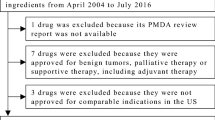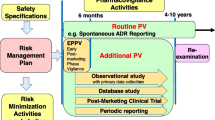Abstract
Revisions of drug package inserts (PIs) may be made immediately after approval or after considerable clinical experience; however, it is unclear whether there is a relationship between the characteristics of these safety measures and the period since drug approval. Here, we analyzed 209 cases of safety measures (revisions of the PIs) taken in Japan over 5 years (FY2014 to FY2018). The median, minimum, and maximum period from approval date in Japan to PI revision date was 6.29 years (interquartile range 2.68–15.53 years), 0.16 years, and 59.69 years, respectively. The cases were classified into four groups depending on types of adverse reaction and therapeutic category in relation to the national approval date and international birth date, resulting in the grouping together of particular adverse reactions and therapeutic drugs. For example, “Hepatobiliary disorders”, “Blood and lymphatic system disorders”, “Respiratory, thoracic and mediastinal disorders”, “Antineoplastics”, “Chemotherapeutics”, and “Other agents affecting metabolism” were associated with the group of safety measures taken early after approval of a drug soon after the international birth date, suggesting that careful attention at an earlier stage after approval is necessary for these adverse reactions and drugs. Understanding such features of PI revisions makes pharmacovigilance planning more appropriate, contributing to the implementation of rapid and proper safety measures after drug approval.



Similar content being viewed by others
References
Pharmaceuticals and Medical Devices Agency. Outline of Post-marketing Safety Measures. https://www.pmda.go.jp/english/safety/outline/0001.html. Accessed 25 Nov 2019.
Ishiguro C, Takeuchi Y, Uyama Y, Tawaragi T. The MIHARI project: establishing a new framework for pharmacoepidemiological drug safety assessments by the Pharmaceuticals and Medical Devices Agency of Japan. Pharmacoepidemiol Drug Saf. 2016;25(7):854–9.
Mori K, Watanabe M, Horiuchi N, Tamura A, Kutsumi H. The role of the Pharmaceuticals and Medical Devices Agency and healthcare professionals in post-marketing safety. Clin J Gastroenterol. 2014;7(2):103–7.
Ishiguro C, Misu T, Iwasa E, Izawa T. Analysis of safety-related regulatory actions by Japan’s pharmaceutical regulatory agency. Pharmacoepidemiol Drug Saf. 2017;26(11):1314–20.
Lester J, Neyarapally GA, Lipowski E, Graham CF, Hall M, Dal Pan G. Evaluation of FDA safety-related drug label changes in 2010. Pharmacoepidemiol Drug Saf. 2013;22(3):302–5.
Pharmaceuticals and Medical Devices Agency. Annual Reports. https://www.pmda.go.jp/english/about-pmda/annual-reports/0001.html. Accessed 25 Nov 2019.
Tamura N, Ishiguro C, Matsuda T. Post-approval appending of CSARs to drug package inserts: an analysis of the types of adverse reactions and time to addition. Pharmacoepidemiol Drug Saf. 2015;24(2):166–75.
Fujikawa M, Ono S. Analysis of safety-related regulatory actions for new drugs in Japan by nature of identified risks. Pharm Med. 2017;31(5):317–27.
Pinnow E, Amr S, Bentzen SM, Brajovic S, Hungerford L, St George DM, et al. Postmarket Safety Outcomes for New Molecular Entity (NME) drugs approved by the food and drug administration between 2002 and 2014. Clin Pharmacol Ther. 2018;104(2):390–400.
Pharmaceuticals and Medical Devices Agency. Revisions of PRECAUTIONS. http://www.pmda.go.jp/english/safety/info-services/drugs/revision-of-precautions/0001.html. Accessed 25 Nov 2019.
Pharmaceuticals and Medical Devices Agency. (in Japanese). http://www.pmda.go.jp/. Accessed 25 Nov 2019.
Pharmaceutical and Medical Device Regulatory Science Society of Japan. MedDRA Japanese Maiontenance Organization. https://www.pmrj.jp/jmo/php/indexj.php. Accessed 25 Nov 2019.
Ministry of Internal Affairs and Communications. Devision 87 Drugs and related commodities http://www.soumu.go.jp/main_content/000294493.pdf. Accessed 25 Nov 2019.
Suzuki Y, Kishi T, Nakamura M, Yamada H. Evaluation of factors influencing addition of clinically significant adverse reactions section in drug package inserts. Iyakuhin Johogaku. 2017;19(1):17–23.
Asano K, Uyama Y, Tohkin M. Factors affecting drug-development strategies in asian global Clinical trials for drug approval in Japan. Clin Transl Sci. 2018;11(2):182–8.
Ueno T, Asahina Y, Tanaka A, Yamada H, Nakamura M, Uyama Y. Significant differences in drug lag in clinical development among various strategies used for regulatory submissions in Japan. Clin Pharmacol Ther. 2014;95(5):533–41.
Pharmaceuticals and Medical Devices Agency. List of Approved Products https://www.pmda.go.jp/english/review-services/reviews/approved-information/drugs/0002.html. Accessed 25 Nov 2019.
Toshikuni N. Therapy with direct-acting antiviral agents for hepatitis c-related liver cirrhosis. Gut Liver. 2017;11(3):335–48.
Arnold FL, Fukunaga S, Kusama M, Matsuki N, Ono S. Assessment of factors associated with dose differences between Japan and the United States. Clin Pharmacol Therap. 2014;95(5):542–9.
Nakashima K, Narukawa M, Kanazu Y, Takeuchi M. Differences between Japan and the United States in dosages of drugs recently approved in Japan. J Clin Pharmacol. 2011;51(4):549–60.
Roujeau JC, Kelly JP, Naldi L, Rzany B, Stern RS, Anderson T, et al. Medication use and the risk of Stevens-Johnson syndrome or toxic epidermal necrolysis. N Engl J Med. 1995;333(24):1600–7.
Rzany B, Mockenhaupt M, Baur S, Schroder W, Stocker U, Mueller J, et al. Epidemiology of erythema exsudativum multiforme majus, Stevens-Johnson syndrome, and toxic epidermal necrolysis in Germany (1990–1992): structure and results of a population-based registry. J Clin Epidemiol. 1996;49(7):769–73.
Sidoroff A, Halevy S, Bavinck JN, Vaillant L, Roujeau JC. Acute generalized exanthematous pustulosis (AGEP)—a clinical reaction pattern. J Cutaneous Pathol. 2001;28(3):113–9.
Pharmaceuticals and Medical Devices Agency. Drug-lag estimation. (in Japanese). https://www.pmda.go.jp/review-services/drug-reviews/about-reviews/p-drugs/0013.html. Accessed 25 Nov 2019.
Ministry of Health, Labour and Welfare. SAKIGAKE designation sheme. (in Japanese). https://www.mhlw.go.jp/seisakunitsuite/bunya/kenkou_iryou/iyakuhin/topics/tp150514-01.html. Accessed 25 Nov 2019.
Yamada K, Itoh M, Fujimura Y, Kimura M, Murata K, Nakashima N, et al. The utilization and challenges of Japan’s MID-NET® medical information database network in post-marketing drug safety assessments: a summary of pilot pharmacoepidemiological studies. Pharmacoepidemiol Drug Saf. 2019;28:601–8.
Sherman RE, Anderson SA, Dal Pan GJ, Gray GW, Gross T, Hunter NL, et al. Real-world evidence—what is it and what can it tell us? N Engl J Med. 2016;375(23):2293–7.
Acknowledgements
We thank Dr Masayuki Nagasaki for his valuable comments on statistical analysis.
Funding
This work was partly supported by a public research grant of Regulatory Science of Pharmaceuticals and Medical Devices from the Japan Agency for Medical Research and Development to Dr Yoshiaki Uyama.
Author information
Authors and Affiliations
Contributions
AH, HH, and YU wrote the manuscript; AH and YU designed the research; AH performed the research and analyzed the data.
Corresponding author
Ethics declarations
Conflict of interest
The authors declared no conflicts of interest. The views expressed herein are the result of independent work and do not necessarily represent the views and findings of the Pharmaceuticals and Medical Devices Agency.
Additional information
Publisher's Note
Springer Nature remains neutral with regard to jurisdictional claims in published maps and institutional affiliations.
Rights and permissions
About this article
Cite this article
Hiramatsu, A., Hanaoka, H. & Uyama, Y. Characteristics on Drug Safety Measures in Japan Stratified by System Organ Classes and Therapeutic Categories in Relation to the Approval Date. Ther Innov Regul Sci 54, 1534–1540 (2020). https://doi.org/10.1007/s43441-020-00180-w
Received:
Accepted:
Published:
Issue Date:
DOI: https://doi.org/10.1007/s43441-020-00180-w




